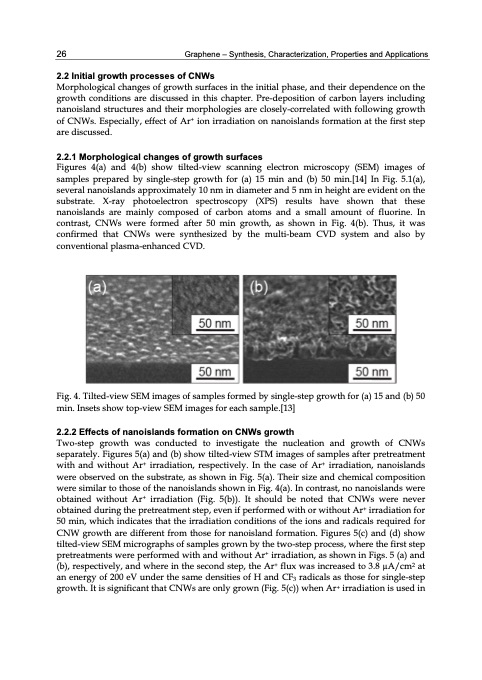
PDF Publication Title:
Text from PDF Page: 036
26 Graphene – Synthesis, Characterization, Properties and Applications 2.2 Initial growth processes of CNWs Morphological changes of growth surfaces in the initial phase, and their dependence on the growth conditions are discussed in this chapter. Pre-deposition of carbon layers including nanoisland structures and their morphologies are closely-correlated with following growth of CNWs. Especially, effect of Ar+ ion irradiation on nanoislands formation at the first step are discussed. 2.2.1 Morphological changes of growth surfaces Figures 4(a) and 4(b) show tilted-view scanning electron microscopy (SEM) images of samples prepared by single-step growth for (a) 15 min and (b) 50 min.[14] In Fig. 5.1(a), several nanoislands approximately 10 nm in diameter and 5 nm in height are evident on the substrate. X-ray photoelectron spectroscopy (XPS) results have shown that these nanoislands are mainly composed of carbon atoms and a small amount of fluorine. In contrast, CNWs were formed after 50 min growth, as shown in Fig. 4(b). Thus, it was confirmed that CNWs were synthesized by the multi-beam CVD system and also by conventional plasma-enhanced CVD. Fig. 4. Tilted-view SEM images of samples formed by single-step growth for (a) 15 and (b) 50 min. Insets show top-view SEM images for each sample.[13] 2.2.2 Effects of nanoislands formation on CNWs growth Two-step growth was conducted to investigate the nucleation and growth of CNWs separately. Figures 5(a) and (b) show tilted-view STM images of samples after pretreatment with and without Ar+ irradiation, respectively. In the case of Ar+ irradiation, nanoislands were observed on the substrate, as shown in Fig. 5(a). Their size and chemical composition were similar to those of the nanoislands shown in Fig. 4(a). In contrast, no nanoislands were obtained without Ar+ irradiation (Fig. 5(b)). It should be noted that CNWs were never obtained during the pretreatment step, even if performed with or without Ar+ irradiation for 50 min, which indicates that the irradiation conditions of the ions and radicals required for CNW growth are different from those for nanoisland formation. Figures 5(c) and (d) show tilted-view SEM micrographs of samples grown by the two-step process, where the first step pretreatments were performed with and without Ar+ irradiation, as shown in Figs. 5 (a) and (b), respectively, and where in the second step, the Ar+ flux was increased to 3.8 μA/cm2 at an energy of 200 eV under the same densities of H and CF3 radicals as those for single-step growth. It is significant that CNWs are only grown (Fig. 5(c)) when Ar+ irradiation is used inPDF Image | GRAPHENE SYNTHESIS CHARACTERIZATION PROPERTIES

PDF Search Title:
GRAPHENE SYNTHESIS CHARACTERIZATION PROPERTIESOriginal File Name Searched:
Graphene-Synthesis.pdfDIY PDF Search: Google It | Yahoo | Bing
Salgenx Redox Flow Battery Technology: Power up your energy storage game with Salgenx Salt Water Battery. With its advanced technology, the flow battery provides reliable, scalable, and sustainable energy storage for utility-scale projects. Upgrade to a Salgenx flow battery today and take control of your energy future.
| CONTACT TEL: 608-238-6001 Email: greg@infinityturbine.com | RSS | AMP |